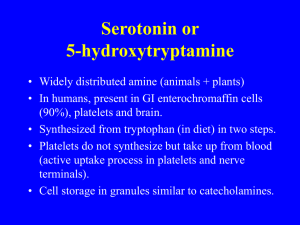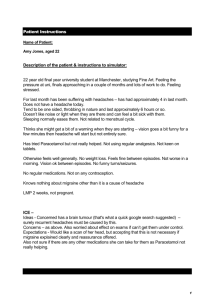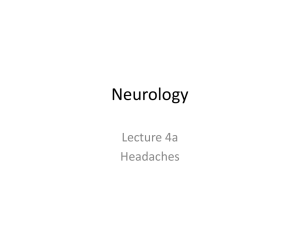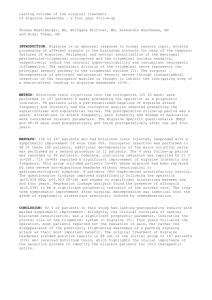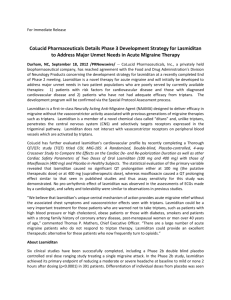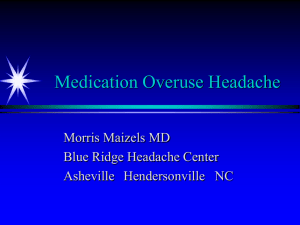Effect of Ergotamine and its Combination with Vitamin E or
advertisement
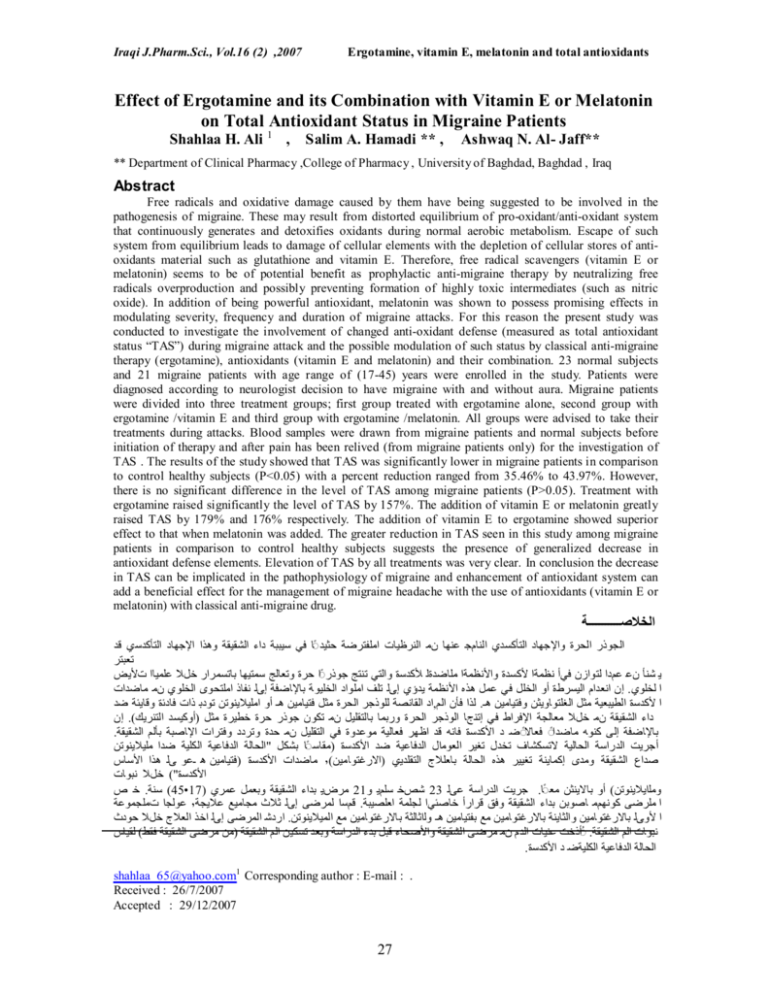
Iraqi J.Pharm.Sci., Vol.16 (2) ,2007 Ergotamine, vitamin E, melatonin and total antioxidants Effect of Ergotamine and its Combination with Vitamin E or Melatonin on Total Antioxidant Status in Migraine Patients Shahlaa H. Ali 1 , Salim A. Hamadi ** , Ashwaq N. Al- Jaff** ** Department of Clinical Pharmacy ,College of Pharmacy , University of Baghdad, Baghdad , Iraq Abstract Free radicals and oxidative damage caused by them have being suggested to be involved in the pathogenesis of migraine. These may result from distorted equilibrium of pro-oxidant/anti-oxidant system that continuously generates and detoxifies oxidants during normal aerobic metabolism. Escape of such system from equilibrium leads to damage of cellular elements with the depletion of cellular stores of antioxidants material such as glutathione and vitamin E. Therefore, free radical scavengers (vitamin E or melatonin) seems to be of potential benefit as prophylactic anti-migraine therapy by neutralizing free radicals overproduction and possibly preventing formation of highly toxic intermediates (such as nitric oxide). In addition of being powerful antioxidant, melatonin was shown to possess promising effects in modulating severity, frequency and duration of migraine attacks. For this reason the present study was conducted to investigate the involvement of changed anti-oxidant defense (measured as total antioxidant status “TAS”) during migraine attack and the possible modulation of such status by classical anti-migraine therapy (ergotamine), antioxidants (vitamin E and melatonin) and their combination. 23 normal subjects and 21 migraine patients with age range of (17-45) years were enrolled in the study. Patients were diagnosed according to neurologist decision to have migraine with and without aura. Migraine patients were divided into three treatment groups; first group treated with ergotamine alone, second group with ergotamine /vitamin E and third group with ergotamine /melatonin. All groups were advised to take their treatments during attacks. Blood samples were drawn from migraine patients and normal subjects before initiation of therapy and after pain has been relived (from migraine patients only) for the investigation of TAS . The results of the study showed that TAS was significantly lower in migraine patients in comparison to control healthy subjects (P<0.05) with a percent reduction ranged from 35.46% to 43.97%. However, there is no significant difference in the level of TAS among migraine patients (P>0.05). Treatment with ergotamine raised significantly the level of TAS by 157%. The addition of vitamin E or melatonin greatly raised TAS by 179% and 176% respectively. The addition of vitamin E to ergotamine showed superior effect to that when melatonin was added. The greater reduction in TAS seen in this study among migraine patients in comparison to control healthy subjects suggests the presence of generalized decrease in antioxidant defense elements. Elevation of TAS by all treatments was very clear. In conclusion the decrease in TAS can be implicated in the pathophysiology of migraine and enhancement of antioxidant system can add a beneficial effect for the management of migraine headache with the use of antioxidants (vitamin E or melatonin) with classical anti-migraine drug. ﺍﻟﺨﻼﺻـــــــــــﺔ ﺍﻟﺠﻭﺬﺭ ﺍﻟﺤﺮﺓ ﻭﺍﻹﺟﻬﺎﺩ ﺍﻟﺘﺄﻛﺴﺪﻱ ﺍﻟﻨﺎﻢﺟ ﻋﻨﻬﺎ ﻦﻣ ﺍﻟﻨﺮﻈﻳﺎﺕ ﺍﻤﻟﻔﺘﺮﺿﺔ ﺣﺜﻳﺪ ًﺎ ﻓﻲ ﺳﻴﺒﺒﺔ ﺩﺍء ﺍﻟﺸﻘﻴﻘﺔ ﻭﻫﺬﺍ ﺍﻹﺟﻬﺎﺩ ﺍﻟﺘﺄﻛﺪﺴﻱ ﻗﺪ ﺗﻌﺒﺘﺮ ﻳًﺸﻨﺄ ﻦﻋ ﻋﻡﺪﺍًﻟﺘﻮﺍﺯﻥ ﻓﻲﺃًﻧﻈﻤﺔﺍًﻷﻛﺴﺪﺓ ﻭﺍﻷﻧﻈﻤﺔﺍًﻤﻟﺎﻀﺩﺓﻟًﻸﻛﺪﺴﺓ ﻭﺍﻟﺘﻲ ﺗﻨﺘﺞ ﺟﻭﺬﺭ ًﺍ ﺣﺮﺓ ﻭﺗﻌﺎﻟﺞ ﺳﻤﺘﻴﻬﺎ ﺑﺎﺘﺳﻤﺮﺍﺭ ﺧﻝﻼ ﻋﻠﻤﻴﺎﺍًﺕﻷﻳﺾ ﺇﻥ ﺍﻧﻌﺪﺍﻡ ﺍﻟﻴﺴﺮﻄﺓ ﺃﻭ ﺍﻟﺨﻠﻞ ﻓﻲ ﻋﻤﻞ ﻫﺬﻩ ﺍﻷﻧﻈﻤﺔ ﻳﺩﺆﻱ ﺇﻰﻟ ﺗﻠﻒ ﺍﻤﻟﻮﺍﺩ ﺍﻟﺨﻠﻳﻮﺔ ﺑﺎﻹﺎﺿﻓﺔ ﺇﻰﻟ ﻧﻔﺎﺫ ﺍﻤﻟﺘﺤﻮﻯ ﺍﻟﺨﻠﻮﻱ ﻦﻣ ﻣﺎﻀﺩﺍﺕ.ﺍًﻟﺨﻠﻮﻱ ﺍﺩ ﺍﻟﻘﺎﻧﺼﺔ ﻟﻠﻭﺬﺠﺭ ﺍﻟﺤﺮﺓ ﻣﺜﻞ ﻓﺘﻴﺎﻣﻴﻦ ﻫـ ﺃﻭ ﺍﻤﻟﻴﻼﻴﻧﻮﺗﻦ ﺗﻭﺪﺒ ﺫﺍﺕ ﻓﺎﺪﺋﺓ ﻭﻗﺎﻴﺋﺔ ﺿﺪ, ﻟﺬﺍ ﻓﺄﻥ ﺍﻟﻢ.ﺍًﻷﻛﺪﺴﺓ ﺍﻟﻄﻴﺒﻌﻴﺔ ﻣﺜﻞ ﺍﻟﻐﻠﺗﻮﺎﻮﻴﺛﻥ ﻭﻓﺘﻴﺎﻣﻴﻦ ﻫـ ﺇﻥ.(ﺩﺍء ﺍﻟﺸﻘﻴﻘﺔ ﻦﻣ ﺧﻝﻼ ﻣﻌﺎﻟﺠﺔ ﺍﻹﻓﺮﺍﻁ ﻓﻲ ﺇﺘﻧﺝﺎ ﺍﻟﻭﺬﺠﺭ ﺍﻟﺤﺮﺓ ﻭﺭﺑﻤﺎ ﺑﺎﻟﺘﻘﻠﻴﻞ ﻦﻣ ﺗﻜﻮﻥ ﺟﻭﺬﺭ ﺣﺮﺓ ﺧﻄﻴﺮﺓ ﻣﺜﻞ )ﺃﻭﻛﻴﺴﺪ ﺍﻟﺘﻨﺮﻳﻚ .ﺑﺎﻹﺎﺿﻓﺔ ﺇﻟﻰ ﻛﻧﻮﻪ ﻣﺎﻀﺩﺍ ً ﻓﻌﺎﻻ ًﺿ ًﺪ ﺍﻷﻛﺪﺴﺓ ﻓﺎﻧﻪ ﻗﺪ ﺍﻇﻬﺮ ﻓﻌﺎﻟﻴﺔ ﻣﻮﻋﺩﻮﺓ ﻓﻲ ﺍﻟﺘﻘﻠﻴﻞ ﻦﻣ ﺣﺪﺓ ﻭﺗﺮﺩﺩ ﻭﻓﺘﺮﺍﺕ ﺍﻹﺎﺻﺑﺔ ﺑﺄﻟﻢ ﺍﻟﺸﻘﻴﻘﺔ ﺃﺟﺮﻳﺖ ﺍﻟﺪﺭﺍﺳﺔ ﺍﻟﺤﺎﻟﻴﺔ ﻻﺘﺳﻜﺸﺎﻑ ﺗﺧﺪﻞ ﺗﻐﻴﺮ ﺍﻟﻌﻮﻣﺍﻞ ﺍﻟﺪﻓﺎﻋﻴﺔ ﺿﺪ ﺍﻷﻛﺪﺴﺓ )ﻣﻘﺎﺳ ًﺎ ﺑﺸﻜﻞ "ﺍﻟﺤﺎﻟﺔ ﺍﻟﺪﻓﺎﻋﻴﺔ ﺍﻟﻜﻠﻴﺔ ﺿﺪﺍ ًﻤﻟﻴﻼﻴﻧﻮﺗﻦ ﻣﺎﻀﺩﺍﺕ ﺍﻷﻛﺪﺴﺓ )ﻓﺘﻴﺎﻣﻴﻦ ﻫ ًـﻋﻭ ًﻰﻠ ﻫﺬﺍ ﺍﻷﺳﺎﺱ٬(ﺻﺪﺍﻉ ﺍﻟﺸﻘﻴﻘﺔ ﻭﻣﺪﻯ ﺇﻜﻣﺎﻴﻧﺔ ﺗﻐﻴﻴﺮ ﻫﺬﻩ ﺍﻟﺤﺎﻟﺔ ﺑﺎﻌﻟﻼﺝ ﺍﻟﺘﻘﻠﺪﻴﻱ )ﺍﻻﺭﻏﺗﻮﺎﻣﻴﻦ ﺍﻷﻛﺪﺴﺓ"( ﺧﻝﻼ ﻧﺑﻮﺎﺕ ﺨًًﺺ.( ﺳﻨﺔ45•17) ﻣﺮﺾﻳ ﺑﺪﺍء ﺍﻟﺸﻘﻴﻘﺔ ﻭﺑﻌﻤﻞ ﻋﻤﺮﻱ21 ﺷﺺﺨ ﺳﻠﻢﻴ ﻭ23 ﺟﺮﻳﺖ ﺍﻟﺪﺭﺍﺳﺔ ﻋﻰﻠ.ﻭﻤﻟﺍﻴﻼﻴﻧﻮﺗﻦ( ﺃﻭ ﺑﺎﻻﻴﻨﺛﻦ ﻣﻌ ًﺎ ﻋﻮﻟﺠﺍًﺖﻤﻟﺠﻤﻮﻋﺔ٬ ﻗﻢﺴﺍًﻟﻤﺮﺿﻰ ﺇﻰﻟ ﺛﻼﺙ ﻣﺠﺎﻣﻴﻊ ﻋﻼﻴﺟﺔ.ﺍًﻤﻟﺮﺿﻰ ﻛﻮﻧﻬﻢﻣًﺎﺼﻮﺑﻥ ﺑﺪﺍء ﺍﻟﺸﻘﻴﻘﺔ ﻭﻓﻖ ﻗﺮﺍﺭﺃًﺧﺎﺼﺋﻲﺍًﻟﺠﻠﻤﺔ ﺍﻌﻟﺼﻴﺒﺔ ﺍﺭﺪﺷ ﺍﻟﻤﺮﺿﻰ ﺇﻰﻟ ﺍﺧﺬ ﺍﻟﻌﻼﺝ ﺧﻝﻼ ﺣﻭﺪﺙ.ﺍًﻷﻭﻰﻟ ﺑﺎﻻﺭﻏﺗﻮﺎﻣﻴﻦ ﻭﺍﻟﺜﺎﻴﻧﺔ ﺑﺎﻻﺭﻏﺗﻮﺎﻣﻴﻦ ﻣﻊ ﺑﻔﺘﻴﺎﻣﻴﻦ ﻫـ ﻭﻟﺍﺜﺎﻟﺜﺔ ﺑﺎﻻﺭﻏﺗﻮﺎﻣﻴﻦ ﻣﻊ ﺍﻟﻤﻴﻼﻴﻧﻮﺗﻦ ًﺃﺬﺧﺕ ﻋﻨﻴﺎﺕ ﺍﻟﺪﻡ ﻦﻣ ﻣﺮﺿﻰ ﺍﻟﺸﻘﻴﻘﺔ ﻭﺍﻷﺻﺤﺎء ﻗﺒﻞ ﺑﺪء ﺍﻟﺪﺭﺍﺳﺔ ﻭﺑﻌﺪ ﺗﺴﻜﻴﻦ ﺍﻟﻢ ﺍﻟﺸﻘﻴﻘﺔ )ﻣﻦ ﻣﺮﺿﻰ ﺍﻟﺸﻘﻴﻘﺔ ﻓﻘﻂ( ﻟﻘﻴﺎﺱ.ﻧﺑﻮﺎﺕ ﺍﻟﻢ ﺍﻟﺸﻘﻴﻘﺔ .ﺍﻟﺤﺎﻟﺔ ﺍﻟﺪﻓﺎﻋﻴﺔ ﺍﻠﻜﻟﻴﺔﺿًﺪ ﺍﻷﻛﺪﺴﺓ shahlaa_65@yahoo.com1 Corresponding author : E-mail : . Received : 26/7/2007 Accepted : 29/12/2007 27 Iraqi J.Pharm.Sci., Vol.16 (2) ,2007 Ergotamine, vitamin E, melatonin and total antioxidants ﺃﻇﻬﺮﺕ ﺍﻟﺘﻨﺎﺋﺞ ﻥﺃ ﺍﻟﺤﺎﻟﺔ ﺍﻟﺪﻓﺎﻋﻴﺔ ﺍﻟﻜﻠﻴﺔ ﺿﺪ ﺍﻷﻛﺪﺴﺓ ﻣﺨﻨﻔﻀﺔ ﻟﺪﻯ ﻣﺮﺿﻰ ﺍﻟﺸﻘﻴﻘﺔ ﺑﺎﻤﻟﻘﺎﺭﻧﺔ ﻣﻊ ﺍﻷﺻﺤﺎء ﻭﻛﺎﻧﺖ ﻧﺒﺴﺔ ﺍﻻﺨﻧﻔﺎﺽ ﻋﻭﻰﻠ ﺃﻳﺔ ﺣﺎﻝ ﻟﻢ ﻳﻜﻦ ﻫﻨﺎﻙ ﻓﻕﺮ ﻣﻨﻄﻘﻲ ﺑﻤﺘﺴﻮﻯ ﺍﻟﺤﺎﻟﺔ ﺍﻟﺪﻓﺎﻋﻴﺔ ﺍﻠﻜﻟﻴﺔ ﺿﺪ ﺍﻷﻛﺪﺴﺓ ﺑﻴﻦ ﻣﺮﺿﻰ.%43.97 ﺇﻰﻟ%35.46 ﺗًﺘﺮﺍﻭﺡ ﺑﻴﻦ ﻛﻤﺎ ﻭﺍﻥ ﺇﺎﺿﻓﺔ.%157 ﻥﺇ ﺍﻌﻟﻼﺝ ﺑﺎﻻﺭﻏﺗﻮﺎﻣﻴﻦ ﻗﺪ ﺃﺩﻯ ﺇﻟﻰ ﺍﺭﺗﻔﺎﻉ ﻣﻨﻄﻘﻲ ﺑﻤﺴﻮﺘﻯ ﺍﻟﺤﺎﻟﺔ ﺍﻟﺪﻓﺎﻋﻴﺔ ﺍﻟﻜﻠﻴﺔﺿًﺪ ﺍﻷﻛﺪﺴﺓ ﺑﺒﺴﻨﺔ.ﺍًﻟﺸﻘﻴﻘﺔ ﺃﻧﻔﺴﻬﻢ ﻭﻋﻰﻠ ﺍﻤﻌﻟﻮﻡ. ﻋﻰﻠ ﺍﻟﻮﺘﺍﻟﻲ%176 ﻭ%179 ﻓًﺘﻴﺎﻣﻴﻦ ﻫـ ﺃﻭ ﺍﻟﻤﻴﻼﻴﻧﻮﺗﻦ ﻗﺪ ﺃﺩﻯ ﺇﻟﻰ ﺍﺭﺗﻔﺎﻉ ﺃﻛﺒﺮ ﻓﻲ ﺍﻟﺤﺎﻟﺔ ﺍﻟﺪﻓﺎﻋﻴﺔ ﺍﻠﻜﻟﻴﺔﺿًﺪ ﺍﻷﻛﺪﺴﺓ ﻭﺒﺴﻨﺑﺔ ﻳﻈﻬﺮ ﺍﻻﺨﻧﻔﺎﺽ ﺍﻟﻜﻴﺒﺮ ﻓﻲ ﺍﻟﺤﺎﻟﺔ.ﻓًﻘﺪ ﺍﻇﻬﺮ ﻓﺘﻴﺎﻣﻴﻦ ﻫـ ﺗﻔﻮﻗﺎ ً ﻓﻲ ﺭﻓﻊ ﺍﻟﺤﺎﻟﺔ ﺍﻟﺪﻓﺎﻋﻴﺔ ﺍﻟﻜﻠﻴﺔ ﺿﺪ ﺍﻷﻛﺪﺴﺓ ﻦﻋ ﺗﻠﻚ ﺍﻟﺘﻲ ﺃﻇﻬﺮﻫﺎ ﺍﻟﻤﻴﻼﻴﻧﻮﺗﻦ ﺍﻟﺪﻓﺎﻋﻴﺔ ﺍﻠﻜﻟﻴﺔ ﺿﺪ ﺍﻷﻛﺪﺴﺓ ﺑﻴﻦ ﻣﺮﺿﻰ ﺍﻟﺸﻘﻴﻘﺔ ﺑﺎﻤﻟﻘﺎﺭﻧﺔ ﻣﻊ ﺍﻷﺻﺤﺎء ﺣﻭﺪﺙ ﻧﻘﺺ ﻋﺎﻡ ﻓﻲ ﺍﻌﻟﻨﺻﺎﺮ ﺍﻟﺪﻓﺎﻋﻴﺔ ﺿﺪ ﺍﻷﻛﺪﺴﺓ ﻛﻤﺎ ﻭﺍﻥ ﺭﻓﻊ ﺗﺘﻨﺘﺴﺞ ﺍﻟﺪﺭﺍﺳﺔ ﺑﺄﻥ ﺍﺨﻧﻔﺎﺽ ﺍﻟﺤﺎﻟﺔ ﺍﻟﺪﻓﺎﻋﻴﺔ ﺍﻠﻜﻟﻴﺔﺿًﺪ ﺍﻷﻛﺪﺴﺓ.ﺍﻟﺤﺎﻟﺔ ﺍﻟﺪﻓﺎﻋﻴﺔ ﺍﻠﻜﻟﻴﺔﺿًﺪ ﺍﻷﻛﺪﺴﺓ ﻛﺎﻥ ﻭﺍﺿﺤﺎ ً ﻋﻨﺪ ﺟﻤﻴﻊ ﺍﻟﻤﺠﺎﻣﻴﻊ ﺍﻌﻟﻼﻴﺟﺔ ﻳﻜﻤﻦ ﺃﻥ ﻳﻜﻮﻥ ﻋﺎﻣﻼ ً ﻓﻲ ﺳﻴﺒﺒﺔ ﺩﺍء ﺍﻟﺸﻘﻴﻘﺔ ﻭﺃﻥ ﺗﺴﺤﻴﻨﻬﺎ ﻗﺪ ﻳﻜﻮﻥ ﺫﺍ ﻓﺎﺪﺋﺓ ﻓﻲ ﻋﻼﺝﺻًﺪﺍﻉ ﺍﻟﺸﻘﻴﻘﺔ ﺑﺎﺪﺨﺘﺳﺍﻡ ﻣﺎﻀﺩﺍﺕ ﺍﻷﻛﺪﺴﺓ ﻣﺜﻞ ﻓﺘﻴﺎﻣﻴﻦ ﻫـ .ﺃﻭ ﺍﻤﻟﻴﻼﻴﻧﻮﺗﻦ ﻣﺎﻀﻓﺔ ً ﺇﻰﻟ ﻋﻼﺟﺎﺕ ﺩﺍء ﺍﻟﺸﻘﻴﻘﺔ ﺍﻟﺘﻘﻠﻳﺪﻴﺔ Introduction (substance P, neurokinin A or calcitonin genrelated polypeptide) ended with sterile or neurogenic inflammation (15). These events were shown to be blocked by sumatriptan or dihydroergotamine (16,17). Calcium channel blockers on the other hand may diminish vasoconstriction whether produced by humoral agents or by intrinsic monoamine pathways; while non-steroidal anti-inflammatory drugs (NSAIDs) presumably suppress the sterile inflammatory response in vessel walls (18, 19). Many authors believe that sterile inflammation within the trigeminovascular system is of great importance in the pathophysiology of migraine headache. This postulate the release of the neurotransmitter substance P, vasodilation, increased vessel permeability, edema of cranial blood vessels and sensitization of sensory nerve endings (20). Biochemical mediators, like nitric oxide and prostaglandins (PGs) may participate in such scenario; where PGE2 and TXA2 levels are shown to be elevated in saliva from patients with migraine headache during acute attacks (21). Furthermore, nitric oxide has the potential to induce oxidative stress by acting as a free radical through the peroxidation pathway (22). The concept of oxidative stress has been accepted in the increasing association of diseases with advanced age. The plausible explanation for such association is based on the implication of free radicals in the pathogenesis of several disorders like cancer and atherosclerosis (23,24,25).Oxidative stress, however, results from distorted equilibrium of pro-oxidant/anti-oxidant system in intact cell. Such system continuously generates and detoxifies oxidants during normal aerobic metabolism (26). Outbalancing such equilibrium leads to damage of lipids, proteins, carbohydrates and nucleic acids; these events might deplete cellular stores of anti-oxidants material such as glutathione and vitamin E (27). Treatment of acute attacks of migraine is achieved with the use of ergotamine. The effectiveness of ergotamine in treatment of migraine attacks was thought to be related to its α-antagonistic activity; in addition the drug is The pathophysiological mechanisms of migraine have been discussed for years to be involving the humoral-vascular and neurogenic theories (1). The constriction of cortical vessels may explain the aura, while dilation of extracortical (meningeal) vessels may underlay the throbbing headache (2). Cerebral hypoxia secondary to vasospasm or platelet aggregation may explain impaired vision predisposing migraine headache (3).Causative factors for cerebral vasospasm could be the alteration in ion concentration (low intracellular Mg+2) (4, 5), abnormally released serotonin secondary to platelets aggregation (6), endothelin receptor gene polymorphism (7), impaired mitochondrial oxidative metabolism and altered nitric oxide synthesis and release (8,9,10). The neurogenic theory is strongly postulated without excluding aspects of the humoral theory (2). The familial nature of migraine is greatly linked to the hereditary abnormality of monoaminergic transmission (11). This transmission is vulnerable to sudden changes in internal or external environment to emotional stress, or to overload of afferent systems by excessive glare, smell or other stimuli. Triggering factors, thus could induce a phase of excessive discharge followed by a state of monoamine depletion, hence pain gates would be opened, giving rise to spontaneous pain in the head and neck (12). Many evidences suggest the involvement of serotonin and norepinephrine to be the monoamines of great interest in the pathophysiology of migraine; the effectiveness of anti-migraine drugs like methysergide , pizotifen (serotonin receptors antagonists) and β-blockers (block the action of norepinephrine) solidify such suggestion (13,14). Beside that, the level of serotonin metabolities (5-hydroxyindolacetic acid) is highly elevated in plasma from patients during acute migraine (2). Change in serotonin level can provoke a neurovascular reaction which involve not only constriction or dilation of cerebral and extracerebral blood vessels but also activate nociceptive trigeminovascular system, an effect enforced by releasing vasoactive neuropeptides 28 Iraqi J.Pharm.Sci., Vol.16 (2) ,2007 Ergotamine, vitamin E, melatonin and total antioxidants treated with ergotamine (1mg) alone, second group with ergotamine (1mg)/vitamin E (400mg) and third group with ergotamine (1mg)/melatonin (3mg). All groups were advised to take their treatments during attacks. Blood samples were drawn from migraine patients and normal subjects before initiation of therapy and after pain has been relived (from migraine patients only) for the investigation of TAS using Randox TAS kit. Method of measurement was followed according to the instructions mentioned in Randox TAS kit. Data were expressed as mean ± standard deviation and differences between means were analyzed by Student’s ttest. P values less than 0.05 were considered significantly different. known to stimulate 5-HTD1 receptors of the cerebrovascular system. However; several limitations may restrict the use of ergotamine for migraine patients, these include: pregnancy; sepsis; hypertension; cerebral, coronary and peripheral vascular diseases; hepatitis; and renal insufficiency. In addition, the drug has many side effects such as abdominal cramps, parasthesia, nausea and tightness of the chest (2 ). Melatonin, an endogenous neurohormon, shows a promising effect in relieving migraine headache by means of reducing the severity, frequency and duration of migraine attacks (28). The mechanism by which melatonin exert such effect has yet been proven, but this agent possessing many pharmacological properties like scavenging free radicals (29), inhibiting nitric oxide synthase (30), regulating neurovascular system (31) and modulating serotonin actions (32). In the view of the association of various vascular disorders with oxidative stress (33) and because one of the theories of migraine postulate the change in cerebrovascular milieu, the present study was conducted to investigate the involvement of changed anti-oxidant defense (measured as total antioxidant status) during migraine attack and the possible modulation of such status by classical anti-migraine therapy (ergotamine), antioxidants (vitamin E and melatonin) and their combination. Results Table (1) and figure (1) showed that TAS was significantly lower in migraine patients (P<0.05) in comparison to control (normal subjects) with a percent reduction in TAS was ranged from 35.46% to 43.97%. However, there is no significant difference in the level of TAS among migraine patients (P>0.05). Table (1) clearly showed that ergotamine rise significantly the level of TAS by 157%. Interestingly, the addition of vitamin E and melatonin greatly raised TAS by 179% and 176% respectively. This accompanied by shortening the time required for pain to alleviate. Ergotamine treated group required (6.28 ± 3.77 hr) for the pain to alleviate; while ergotamine/vitamin E and ergotamine/melatonin required (4.84 ± 3.6 hr) and (2.77 ± 1.4 hr) respectively. However; only melatonin showed significant difference (P<0.05) in the time required for the pain to alleviate among other therapies. Although the percent improvement in TAS in patients treated with ergotamine/vitamin E and ergotamine/melatonin appears to be similar, there is a significant difference toward the superiority of vitamin E over melatonin when added to ergotamine. In this regard, it seems that the addition of melatonin did not significantly improve TAS over that produced by ergotamine alone (figure 1). Materials and Methods Materia ls: Ergotamine tartrate (as Cafergot® 1mg tablets, Novartis, Switzerland), Vitamin E (as 400 capsules, Cipla, India), Melatonin (as 3mg tablets, American Nutri-ceutical, USA), Total antioxidant status (TAS) Kit, (Randox Laboratories Ltd, UK). Patients Twenty-three normal subjects and 21 migraine patients with age range of (17-45) years were enrolled in this study for three months. For inclusion, patients had to have a long-term history of migraine with and without aura diagnosed according to neurologist decision at specialized neurological centers and were managed under neurologist supervision. Patients who are smokers, alcoholics or those with other apparent disease were excluded. No changes in patients’ً medications were made during the study and patients were instructed to keep taking their medications. Migraine patients were divided into three treatment groups; first group 29 Iraqi J.Pharm.Sci., Vol.16 (2) ,2007 Ergotamine, vitamin E, melatonin and total antioxidants Table (1): Effect of treatments of migraine patients with e rgotamine and its combination with vitamin E and melatonin on serum TAS. Discussion: Free radicals in the brain and the implication of oxidative damage caused by them have recently being implicated to playing possible role in the pathogenesis of migraine headache. The greater reduction in TAS seen in this study among migraine patients in comparison to control healthy subjects suggests the presence of generalized decrease in antioxidant defense elements. TAS enables assessment of integrated antioxidant system which encompasses all biological components with antioxidant activity. Reduction in TAS has been implicated in several disease stats such as cancer, ischemic heart diseases and poor nutritional stats (34, 35). The most convincing evidence for free radical activity comes from nitric oxide, which is a potent vasodilator and is an important biochemical in the trigeminalvascular peripheral mechanism of migraine headache (36,37). Infusion of NO donor (glyceryl trinitrate and sodium nitroprusside), immediately induce headache both in healthy subjects and patients suffering from primary headaches with higher intensity in maigiane patients; while slow injection of the nonspecific inhibitor of NO synthase (L-NAM) reduced the spontaneous activity in all neurons (8,38,39). Koulchitsky and coworkers, suggest that NO can induce activation of central trigeminal neurons and that endogenous release of NO may contribute to the ongoing activity of these neurons. The delayed changes in neuronal activity may include gene expression of pro-nociceptive mediators (46). In addition, migraine can be induced via a cGMPdependent mechanism. Kruuse and coworkers showed that sildenafil significantly induce migraine symptoms and propose that triggering mechanisms may reside within the perivascular sensory nerve terminals or the brainstem (41). NO may interact with other mechanisms for the precipitation of migraine. Strecker and coworkers showed that NO increases meningeal blood flow, an action depends partly on the release and vasodilatory action of calcitonin gene-related peptide (CGRP) from dural afferents; while, prostaglandins show only minimal interaction with NO in this respect (15). Furthermore, platelet levels of nitric oxide, as well as nitric oxide metabolites such as nitrate/nitrite, are increased in migraine patients and rise further during attacks (9,10). Therefore, free radical scavengers may provide a potential Serum Total Antioxidant Status (mmol/L) Control (n=23) Pretreatment 1.41 ± 0.22 Posttreatment --- Ergotami ne/ Vi t E (n=8) Ergotami ne (n=7) a 0.86 ± 0.15 1.35 ± 0.25 * b a 0.91 ± 0.15 1.63 ± 0.09 * b b Ergotami ne/ Mel atoni n (n=6) 0.79 ± 0.12 b 1.39 ± 0.80 * a Data are resented as mean ± SD.n= number of patients.*P<0.05 with respect to pre-treatment value. Non-identical superscripts (a,b) among different groups considered significantly different, P<0.05. Pre-treatment 2.4 2 TAS (mmol/L) a * Post-treatment a b * * 1.6 1.2 0.8 0.4 0 Control Ergotamine Ergotamine/ Vit E Ergotamine/ Melatonin Fig. (1): Serum total antioxidant status in control subjects and mig raine patients treated with ergotamine (n=7), Ergotamine/Vitamin E (n=8) and Ergotamine/Melatonin (n=6). Data are presented as mean ± SD. *P<0.05 with respect to pre-treatment value (by pa ired Student’s t-test). Non-identical supe rscripts (a,b) considered significantly diffe rent, P<0.05 (by unpaired Student’s t-test). 30 Iraqi J.Pharm.Sci., Vol.16 (2) ,2007 Ergotamine, vitamin E, melatonin and total antioxidants molecular basis for prophylactic antimigraine therapy by neutralizing nitric oxide overproduction and possibly preventing formation of highly toxic peroxynitrite. Interesting results were observed in this study by observing greater elevation of TAS by antimigraine treatments. In deed, the addition of antioxidants (vitamin E or melatonin) to the traditional treatment (ergotamine) greatly potentiate the effect . Although the present study did not concerned with the mechanism of such an elevation in TAS, it seems that the vasoconstriction effect of ergotamine may involved these events. However, the link between effect of ergotamine and the elevation in TAS is the spotlight for further investigation. Vitamin E is powerful antioxidant that scavenges free radicals within the lipid phase of the cell (42). In addition, it have a structural role in stabilizing membranes (43), thus nowadays, vitamin E is implicated in the therapy of many diseases (44, 45). Melatonin, beside its known antioxidant activity, it was shown to possess the ability to minimize the intensity, frequency and duration of acute migraine attacks (28). In addition, melatonin has many pharmacological effects, of them is the inhibition of nitric oxide synthase (30,46), whether this feature is involved in the relief of migraine headache or in the elevation of TAS this is require further investigation. In our study, melatonin showed no superiority to vitamin E when added to ergotamine with high standard deviation. This may be explainedby administration of single rather than maintenance dose of melatonin together with greater fluctuation in plasma melatonin level due to diurnal variation (melatonin plasma level is 10 times higher during night that during the daytime) (47). The age is also an important factor; as we got older the plasma concentration of melatonin decline sharply (48). The present study concluded that the decrease in TAS can be implicated in the pathophysiology of migraine. In addition, enhancement of antioxidant system can add a beneficial effect for the management of migraine headache with the use of antioxidants with classical anti-migraine drug. References 1. 2. 3. 4. 5. 6. 7. 8. 9. 10. 11. Acknowledgments The authors grateful Dr. Zuhair Abdul Gafoor (neurologist) and Dr. Ibrahem Adham, Dr. May AL-Sabag, and Dr. Haider Fakhry (Clinical Pharmacist) for their kind help in performing this study. This research is abstracted from High Diploma dissertation submitted to clinical pharmacy department . 12. 13. 31 Crowell, G.F. and Carlin, L.I.: Neurologic complications of migraine. Am. Fam. Physicn. 1982; 26: 139-148. Rang, H.P.; Dale, M.M. and Ritter, J.M.: Clinical conditions in which 5-HT plays a role. In: Pharmacology (4 th ed.), Churchill Livingstone, London, 1999, pp. 171-172. Marles, R. J.; Kaminski, J.; Arnason, J. T.; Pazos-Sanou, L.; Heptinstall, S.; Fischer, N. H.; Crompton, C. W.; Kindack, D. G. and Awang, D. V. C.: A bioassay for inhibition of serotonin release from bovine platelets. J. Natural Products. 1992, 55(8): 1044-1056. McCarty, W.: Magnesium taurate and fish oil for prevention of migraine. Medical Hypothesis 1996; 47:461-466. Facchinetti, F.; Sances, G.; Borella, P.; et al.: Magnesium prophylaxis of menstrual migraine: Effects on intracellular magnesium. Headache 1991; 31: 298-301. Weber, J.T.; Oconnor, M.F.; Hayataka, K.; Colson, N.; Medora, R.; Russo, E.B. and Parker, K.K.: Activity of parthenolide at 5HT (2 A) receptors. J. Natural Products 1997; 60(6): 651-653. Tzourio, C.; El Amrani, M.; Poirier, O.; Nicaud, V.; Bousser, M.-G.; and Alperovitch, A.: Association between migraine and endothelin type A receptor (ETA -231 A/G) gene polymorphism. Neurology 2001; 56: 1273-1277. Olesen, J.; Thomsen, L. L.; Lassen, L. H. and Olesen, I. J.: The nitric oxide hypothesis of migraine and other vascular headaches. Cephalalgia 1995; 15: 94-100. Shimomura, T.; Murakami, F.; Kotani, K.; Ikawa, S. and Kono, S.: Platelet nitric oxide metabolites in migraine. Cephalalgia 1999; 19: 218-222. Stepien, A.; Chalimoniuk, M.; Stepien, A. and Chalimoniuk, M.: Level of nitric oxidedependent cGMP in patients with migraine. Cephalalgia 1998; 18: 631-634. Waeber, C. and Moskowitz, M.A.: Therapeutic implications of central and peripheral neurologic mechanisms in migraine. Neurology. 2003; 61(8 Suppl 4): S9-S20. Van den Bergh,V.; Amery, W.K. and Waelkens, J.: Trigger factors in migraine: a study conducted by the Belgian migraine Society Headache 1987; 27:191-196. Silberstein, S.D.: Evidence-based guidelines for migraine headache. Neurology 2000; 55: 754-762. Iraqi J.Pharm.Sci., Vol.16 (2) ,2007 Ergotamine, vitamin E, melatonin and total antioxidants 14. Capobianco, D.J.; Cheshire, W.P. and Campbell, J.K.: An overview of the diagnosis and pharmacologic treatment of migraine. Mayo. Clinic. Proceedings. 1996; 71(11): 1055-1066. 15. Strecker, T.; Dux, M. and Messlinger, K.: Increase in meningeal blood flow by nitric oxide - interaction with calcitonin generelated peptide receptor and prostaglandin synthesis inhibition. Cephalalgia. 2002; 22(3): 233-41. 16. Akpunonu, B.E.; Mutgi, A.B.; Federman, D.J.; et al.: Subcutaneous sumatriptan for treatment of acute migraine in patients admitted to the emergency department: a multicenter study. Ann. Emerg. Med. 1995; 25: 464-469. 17. Becker, W.J.; Riess, C.M. and Hoag, J.: Effectiveness of subcutaneous dihydroergotamine by home injection for migraine. Headache 1996; 36: 144-148. 18. Parantainen, J. and Vapaatalo, H.: Prostaglandins. In: The pathophysiology of migraine. Prostaglandins: Biology and chemistry of prostaglandins and related eicosanoids. Curtis-Prior, B.P. (Ed.), Churchill Livingstone, Edinburgh, 1988; 386-401. 19. Tfelt-Hansen, P. and McEwen, J.: Nonsteroidal anti-inflammatory drugs in the acute treatment of migraine. In: The Headaches (2 nd ed.). Olesen, J.; TfeltHansen, P. and Welch, K.M.A. (EDs), Lippincott, Williams and Wilkins, Philadelphia, 2000; 391-397. 20. Moskowitz, M.A.: The neurobiology of vascular head pain. Ann. Neurol. 1984; 16: 157-168. 21. Tuca, J.O.; Planas, J.M. and Parellada, P.P.: Increase in PGE2 and TXA2 in the saliva of common migraine patients. Action of calcium channel blockers. Headache 1989; 29: 498-501. 22. Bagchi, K. and Puri, S.: Free radicals and antioxidants in health and disease. East. Medi. Health J. 1998; 4(2): 350-360. 23. Harman, D.: Role of free radical in aging and disease. Ann. N.Y. Acad. Sci. 1992; 673: 126-141. 24. Lea, A.J.: Dietary factors associated with death rates from certain neoplasms in man. Lancet ; 1966; 2(7458): 332-333. 25. Halliwell, B. and Gutteridge, J.M.C.: Free radicals in biology and medicine (2 nd ed.), Oxford, Clarendon press, 1989. 26. Afanas'ev, I.B.: Mechanism of superoxidemediated damage relevance to mitochondrial aging. Ann. N.Y. Acad. Sci. 2004; 1019: 343-345. 27. Smythies J.: Recent advances in oxidative stress and antioxidants in medicine. J. Orthomolecular Medicine 1998; 13(1): 1118. 28. Muqdam, M.M.; Salim, A.H. and Ashwaq, N.E.: Clinical evaluation of melatonin alone and in combination with pizotifen in the prophylaxis of migraine. Iraqi J. Pharm. Sci. 2007; 16(1): 1-7. 29. Reiter, R.J.; Calvo, J.R.; Karbownik, M.; Qi, W. and Tan, D.X.: Melatonin and its relation to the immune system and inflammation. Ann. N.Y. Acad. Sci. 2000; 917: 376-386. 30. Bettahi, I.; Pozo, D.; Osuna, C.; Reiter, R.J.; Acuna-Castroviejo, D. and Guerrero, J.M.: Melatonin reduces nitric oxide synthase activity in rat hypothalamus. J. Pineal Res. 1996; 20: 205-210. 31. Savaskan, E.; Olivieri, G.; Brydon, L.; Jockers, R.; Krauchi, K. and Wirz-Justice, A.: Cerebrovascular melatonin MT1receptor alterations in patients with Alzheimer's disease. Neurosci Lett. 2001; 308: 9-12. 32. Monnet, F.P.: Melatonin modulates [3H] serotonin release in the rat hippocampus: effects of circadian rhythm. J. Neuroendocrinol. 2002; 14: 194-199. 33. Langseth, L.: Antioxidant vitamins and disease prevention. Food Technol. 1994; 7: 80-84. 34. Zachwieja, J.; Bobkowski, W.; Niklas, A.; et al.: Total antioxidant status in children with nephritic syndrome. POI Merkuriusz lek. 2000; 8 (46): 216-7. 35. Car, N.; Vucic, M.; Car, A.; et al.: Superoxide dismutase and total antioxidant status in patient with diabetic ketoacidosis. Diabiologia Croatica. 2000; 29-4:193-196. 36. Silberstein, S.D.; Lipton, R.B. and Goadsby, P.J. (EDs): The pathophysiology of primary headache. In: Headache in Clinical Practice. Oxford, England: Isis Medical Media; 1998; 41-58. 37. Srikiatkhachorn, A.; Suwattanasophon, C.; Ruangpattanatawee, U. and PhansuwanPujito, P.: 5-HT2A receptor activation and nitric oxide synthesis: A possible mechanism determining migraine attacks. Headache 2002; 42: 566-574. 38. Iversen, H.K.; Olesen, J.; and Tfelt-Hansen, P.: Intravenous nitroglycerin as an 32 Iraqi J.Pharm.Sci., Vol.16 (2) ,2007 39. 40. 41. 42. 43. Ergotamine, vitamin E, melatonin and total antioxidants experimental model of vascular headache. Basic characteristics. Pain 1989; 38: 17-24. Tassorelli, C.; Joseph, S.A.; Buzzi, M.G. and Nappi, G.: The effects on the central nervous system of nitroglycerin - putative mechanisms and mediators. Prog. Neurobiol. 1999; 57: 607-624. Koulchitsky, S.; Fischer, M.J.M.; De Col, R.; Schlechtweg, P.M. and Messlinger, K.: Biphasic response to nitric oxide of spinal trigeminal neurons with meningeal input in rat – possible implications for the pathophysiology of headaches. Neurophysiol 2004; 92: 1320-1328. Kruuse, C.; Thomsen, L.L.; Birk, S. and Olesen, J.: Migraine can be induced by sildenafil without changes in middle cerebral artery diameter. Brain 2003; 126(1): 241-247. Esterbaner, H.; Dieber-Rotheneder, M.; Striegl, G.; el al.: Role of vitamin E in preventing the oxidation of low-density lipoprotein. Am. J. Clin. Nutr. 1991: 53(suppl 1): 314S-321S. Urano, S.; Inomori, Y.; Sugawara, T.; et al.: Vitamin-E inhibition of retinol-induced hemolysis and membrane-stabilizing behavior. J.Biol. Chem. 1992; 267: 1836518370. 44. Swann, I.L. and Kendra, J.R.: Anaemia, vitamin E deficiency and failure to thrive in an infant. Clin. Lab. Haematol. 1998; 20(1): 61-63. 45. Sokol, R.I.: Vitamin E deficiency and neurologic disease. Ann. Rev. Nutr. 1988:8:351-73. 46. Leon. J.; Escames, G.; Rodrgí uez , M.I.; Lopez, L.C.; Tapias, V.; Entrena, A.; Camacho, E.; Carrion, M.D.; Gallo, M.A.; Espinosa, A.; Tan, D.X.; Reiter, R.J. and Acuna-Castroviejo, D.: Inhibition of neuronal nitric oxide synthase activity by N1-acetyl-5-methoxykynuramine, a brain metabolite of melatonin. J. Neurochem. 2006; 98(6): 2023-2033. 47. Takimoto, M.; Hamada, A.; Tomoda, A.; Ohdo, S.; Ohmura, T.; Sakato, H.; Kawatani, J.; Jodoi, T.; Nakagawa, H.; Terazono, H.; Koyanagi, S.; Higuchi, S.; Kimura, M.; Tukikawa, H.; Irie, S.; Saito, H. and Miike, T.: Daily expression of clock genes in whole blood cells in healthy subjects and a patient with circadian rhythm sleep disorder. Am. J. Physiol. Regul. Integr. Comp. Physiol. 2005; 289: R1273-R1279. 48. Humbert, W. and Pevet, P.: The decrease of pineal melatonin production with age. Causes and consequences. Ann. N.Y. Acad. Sci. 1994; 719: 43-63.
